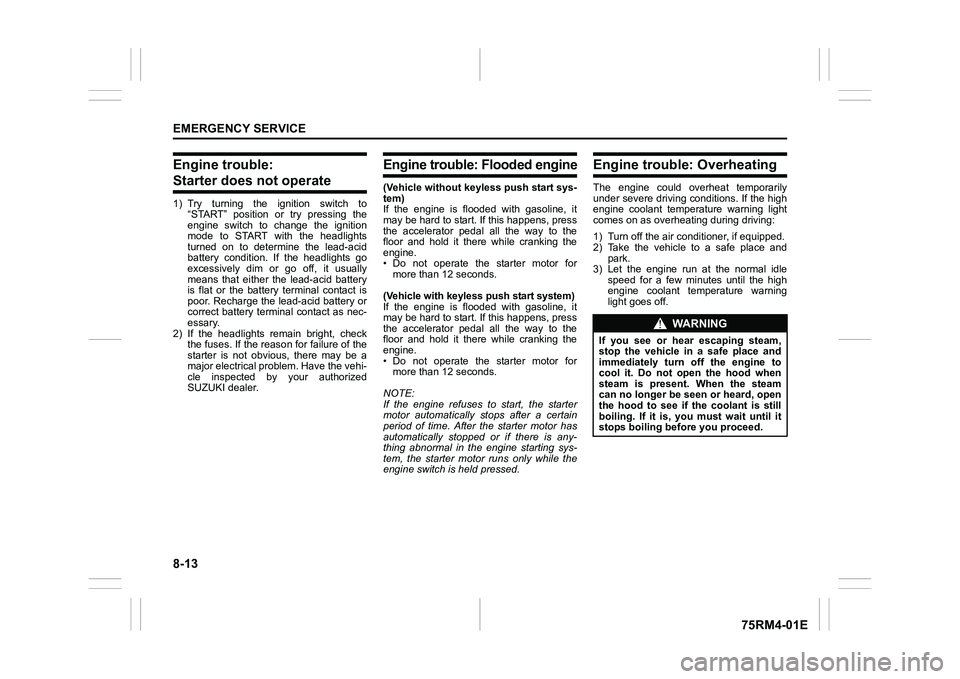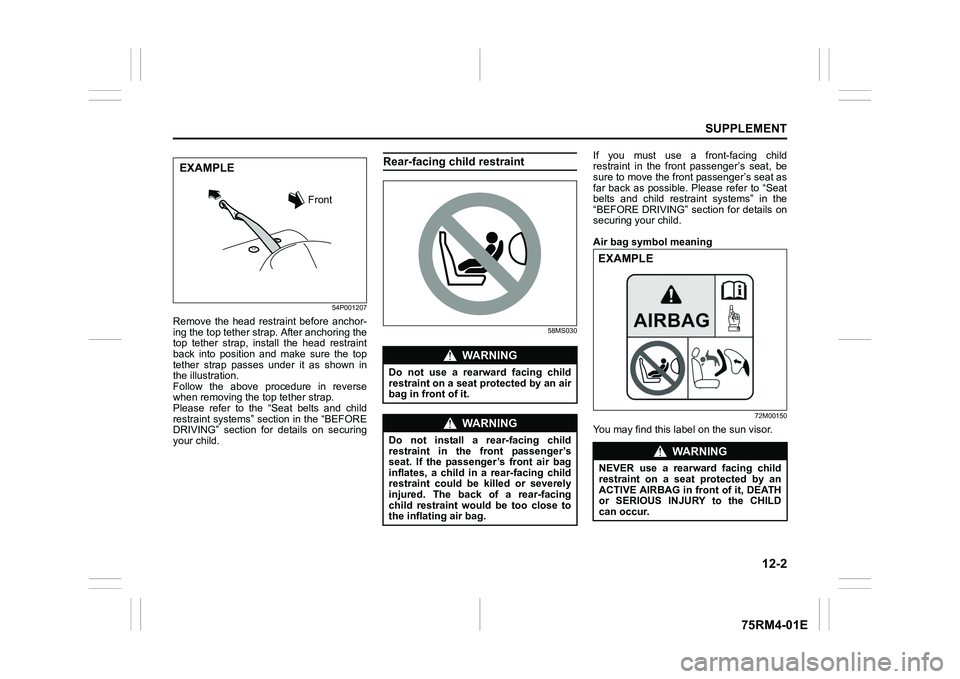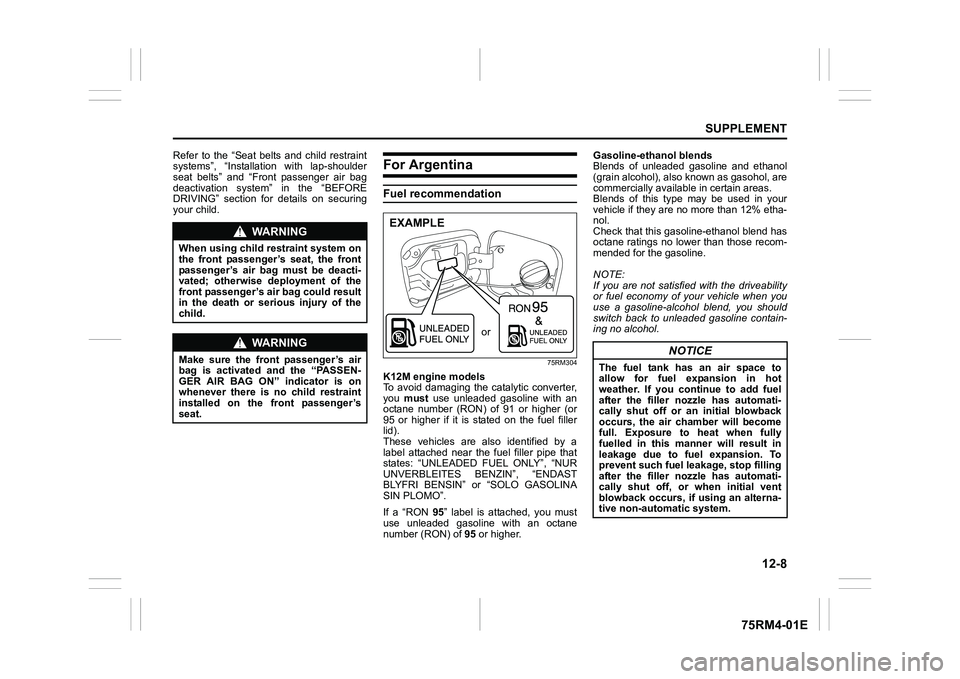before driving SUZUKI IGNIS 2022 Owners Manual
[x] Cancel search | Manufacturer: SUZUKI, Model Year: 2022, Model line: IGNIS, Model: SUZUKI IGNIS 2022Pages: 505, PDF Size: 8.36 MB
Page 415 of 505

8-6
EMERGENCY SERVICE
75RM4-01E
IMPORTANT
The flat tire repair kit cannot be used in
the following cases. Consult a SUZUKI
dealer or a roadside assistance service.
• Cuts or piercing in the tire treadlarger than approx. 4 mm.
• Cuts in the tire side wall.
• Tire damage caused by driving with considerably reduced tire pressure or
even with deflated tire.
• The tire bead completely unseated outside of the rim.
• The rim damaged.
Small punctures in the tire tread,
caused by a nail or a screw, can be
sealed with the flat tire repair kit.
Do not remove nails or screws from the
tire during an e mergency repair. Flat tire repair kit contents
81P70030
(1) Air compressor
(2) Sealant bottle
(3) Filler hose
(4) Valve insert remover
(5) Valve insert (spare)
(6) Speed restriction sticker
(1)(3)
(4)
(5)
(6)(2)
EXAMPLE
WA R N I N G
Flat tire repair kit sealant is harmful if
swallowed, or if it comes in contact
with skin or eyes. If swallowed, do
not induce vomiting. Give plenty of
water (if possible charcoal slurry)
and seek medical attention immedi-
ately. If sealant gets in eyes, flush
eyes with water and seek medical
attention. Wash thoroughly after han-
dling. Solution can be poisonous to
animals. Keep out of the reach of
children and animals.
NOTICE
Replace the sealant before expiry
date indicated on the label of the
sealant bottle. To purchase new seal-
ant, see your SUZUKI dealer.
Page 422 of 505

8-13EMERGENCY SERVICE
75RM4-01E
Engine trouble: Starter does not operate1) Try turning the ignition switch to“START” position or try pressing the
engine switch to change the ignition
mode to START with the headlights
turned on to determine the lead-acid
battery condition. If the headlights go
excessively dim or go off, it usually
means that either the lead-acid battery
is flat or the battery terminal contact is
poor. Recharge the lead-acid battery or
correct battery terminal contact as nec-
essary.
2) If the headlights remain bright, check the fuses. If the reas on for failure of the
starter is not obvious, there may be a
major electrical problem. Have the vehi-
cle inspected by your authorized
SUZUKI dealer.
Engine trouble: Flooded engine(Vehicle without keyless push start sys-
tem)
If the engine is flooded with gasoline, it
may be hard to start. If this happens, press
the accelerator pedal all the way to the
floor and hold it there while cranking the
engine.
• Do not operate the starter motor for more than 12 seconds.
(Vehicle with keyless push start system)
If the engine is flooded with gasoline, it
may be hard to start. If this happens, press
the accelerator pedal all the way to the
floor and hold it there while cranking the
engine.
• Do not operate the starter motor for more than 12 seconds.
NOTE:
If the engine refuses to start, the starter
motor automatically stops after a certain
period of time. After the starter motor has
automatically stopped or if there is any-
thing abnormal in the engine starting sys-
tem, the starter motor runs only while the
engine switch is held pressed.
Engine trouble: OverheatingThe engine could overheat temporarily
under severe driving conditions. If the high
engine coolant temperature warning light
comes on as overheating during driving:
1) Turn off the air conditioner, if equipped.
2) Take the vehicle to a safe place and park.
3) Let the engine run at the normal idle speed for a few minutes until the high
engine coolant temperature warning
light goes off.
WA R N I N G
If you see or hear escaping steam,
stop the vehicle in a safe place and
immediately turn off the engine to
cool it. Do not open the hood when
steam is present. When the steam
can no longer be seen or heard, open
the hood to see if the coolant is still
boiling. If it is, you must wait until it
stops boiling before you proceed.
Page 429 of 505

9-4
APPEARANCE CARE
75RM4-01E
Cleaning exteriorCaring for aluminum wheels
NOTE:
• Do not use an acidic or alkaline deter-gent, or a cleaner containing petroleum
solvent to wash aluminum wheels.
These types of cleaner will cause per-
manent spots, discoloration and cracks
on finished surfaces and damage to cen-
ter caps.
• Do not use a bristle brush and soap con-
taining an abrasive material. These will
damage finished surfaces.
WashingWashing by hand
60B212S
When washing the vehicle, park it in the
place where direct sunlight does not fall on
it and follow the in structions below:
1) Flush the underside of body and wheel housings with pressurized water to
remove mud and debris. Use plenty of
water.
2) Rinse the body to loosen the dirt. Remove dirt and mud from the body
exterior with running water. You may
use a soft sponge or brush. Do not use
hard materials which can scratch the
paint or plastic. Remember that the
headlight covers or lenses are made of
plastic in m any cases.
NOTICE
It is important that your vehicle be
kept clean and free from dirt. Failure
to keep your vehicle clean may result
in fading of the paint or corrosion to
various parts of th e vehicle body.
WA R N I N G
• Never attempt to wash and wax
your vehicle with the engine run-
ning.
• When cleaning the underside of the
body and fender, where there may
be sharp-edged parts, wear gloves
and a long-sleeved shirt to protect
your hands and arms from being
cut.
• After washing your vehicle, care-
fully test the brakes before driving
to check that they have maintained
their normal effectiveness.
NOTICE
When washing the vehicle:
• Avoid directing steam or hot waterof more than 80°C (176°F) on plas-
tic parts.
• To avoid damaging engine compo- nents, do not use pressurized
water in the engine compartment.
NOTICE
To avoid damage to the paint or plas-
tic surface, do not wipe the dirt off
without ample water. Follow the
above procedure.
Page 441 of 505

12-2
SUPPLEMENT
75RM4-01E
54P001207
Remove the head restraint before anchor-
ing the top tether strap. After anchoring the
top tether strap, install the head restraint
back into position and make sure the top
tether strap passes under it as shown in
the illustration.
Follow the above procedure in reverse
when removing the top tether strap.
Please refer to the “Seat belts and child
restraint systems” section in the “BEFORE
DRIVING” section for details on securing
your child.
Rear-facing child restraint
58MS030
If you must use a front-facing child
restraint in the front passenger’s seat, be
sure to move the front passenger’s seat as
far back as possible. Please refer to “Seat
belts and child restraint systems” in the
“BEFORE DRIVING” section for details on
securing your child.
Air bag symbol meaning
72M00150
You may find this label on the sun visor.
Front
EXAMPLE
WA R N I N G
Do not use a rearward facing child
restraint on a seat protected by an air
bag in front of it.
WA R N I N G
Do not install a rear-facing child
restraint in the front passenger’s
seat. If the passenger’s front air bag
inflates, a child in a rear-facing child
restraint could be killed or severely
injured. The back of a rear-facing
child restraint would be too close to
the inflating air bag.
WA R N I N G
NEVER use a rearward facing child
restraint on a seat protected by an
ACTIVE AIRBAG in front of it, DEATH
or SERIOUS INJURY to the CHILD
can occur.EXAMPLE
Page 447 of 505

12-8
SUPPLEMENT
75RM4-01E
Refer to the “Seat belts and child restraint
systems”, “Installation with lap-shoulder
seat belts” and “Front passenger air bag
deactivation system” in the “BEFORE
DRIVING” section for details on securing
your child.
For ArgentinaFuel recommendation
75RM304
K12M engine models
To avoid damaging the catalytic converter,
you must use unleaded gasoline with an
octane number (RON) of 91 or higher (or
95 or higher if it is stated on the fuel filler
lid).
These vehicles are also identified by a
label attached near the fuel filler pipe that
states: “UNLEADED FUEL ONLY”, “NUR
UNVERBLEITES BENZIN”, “ENDAST
BLYFRI BENSIN” or “SOLO GASOLINA
SIN PLOMO”.
If a “RON 95” label is attached, you must
use unleaded gasoline with an octane
number (RON) of 95 or higher. Gasoline-ethanol blends
Blends of unleaded gasoline and ethanol
(grain alcohol), also known as gasohol, are
commercially available in certain areas.
Blends of this type may be used in your
vehicle if they are no more than 12% etha-
nol.
Check that this gasoline-ethanol blend has
octane ratings no lower than those recom-
mended for the gasoline.
NOTE:
If you are not satisfied with the driveability
or fuel economy of your vehicle when you
use a gasoline-alcohol blend, you should
switch back to unleaded gasoline contain-
ing no alcohol.
WA R N I N G
When using child restraint system on
the front passenger’s seat, the front
passenger’s air bag must be deacti-
vated; otherwise deployment of the
front passenger’s air bag could result
in the death or serious injury of the
child.
WA R N I N G
Make sure the front passenger’s air
bag is activated and the “PASSEN-
GER AIR BAG ON” indicator is on
whenever there is no child restraint
installed on the front passenger’s
seat.
or
EXAMPLE
NOTICE
The fuel tank has an air space to
allow for fuel expansion in hot
weather. If you continue to add fuel
after the filler nozzle has automati-
cally shut off or an initial blowback
occurs, the air chamber will become
full. Exposure to heat when fully
fuelled in this manner will result in
leakage due to fuel expansion. To
prevent such fuel leakage, stop filling
after the filler nozzle has automati-
cally shut off, or when initial vent
blowback occurs, if using an alterna-
tive non-autom
atic system.